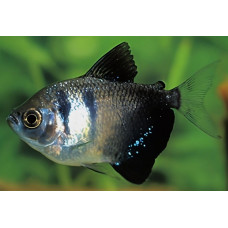Latin name
Gymnocorymbus ternetzi
Other name
Petticoat tetra, high-fin black skirt tetra, black skirt tetra, black widow tetra and blackamoor.
Identification
The black tetra has a flat, tall body.
Features of fish fins
A notable feature of the Characidae family is the presence of an adipose fin. Males have a more pointed dorsal fin. The anal fin resembles an unfurled black fan. There is also a voile form.
Fish colouring
Many species of the Characidae family are brightly coloured and popular as aquarium fish. The black tetra is a silvery fish with three black stripes running across its sides. The first stripe runs across the eye, the second starts after the end of the gill covers and the third starts at the beginning of the upper fin. The rest of the body, including the upper and anal fins, is black, giving the impression of a skirt. Males are almost entirely black. The pectoral, caudal and pelvic fins are transparent. Breeders have bred many colourful forms of ternetzi: orange, bright red, green or blue. They can change colour when conditions deteriorate. When frightened, the fish also change colour, acquiring a silvery-dirty shade.
Distribution
They inhabit Central and South America, Mexico and southwestern Texas, primarily in tropical and near-equatorial regions.
Habitat
It prefers to live in slow-flowing rivers and streams that have plenty of vegetation and shaded areas. It swims in the top layer of the water to catch insects that fall in.
Size
The males are smaller than the females. Adult ternets reach a length of about 3.5–4.5 cm.
Behavior
The fish is peaceful and sociable. It shows activity at all levels. They are energetic and mobile and swim in separate flocks, often attacking one another.
Food and feeding habits
It prefers live food, such as small moths, pipefish, cyclops and daphnia, but can also consume high-quality dry food.
Reproduction
They breed well in captivity. For most species, spawning is stimulated by simulating the rainy season, which involves changing the water to fresh and soft water in large volumes.
The acceptable spawning temperature is +25... +27 °C, with a water hardness of 4 °dH and a pH of 6.8–7.0. Spawning is paired (although gregarious behaviour is sometimes observed). In the aquarium, put the male in first and a few hours later add the female. The next morning, the aquarium should be brightly illuminated to encourage spawning. The lighting can be natural or artificial. The spawning aquarium should have a bottom area of about 1500 cm² (50 x 30 cm) and Javan moss or kapron mesh should be laid on the bottom. The mesh of the kapron netting should be large enough to allow the eggs to fall through freely, but not large enough for the fish to reach them. A pair can produce up to 1,000 and sometimes up to 2,000 eggs in one spawning. After spawning, the producers should be removed. The incubation period lasts 24–36 hours, after which the larvae appear. After 3–5 days, the larvae turn into fry and begin to swim freely and feed.
Aquarium conditions
In a spacious aquarium, they are kept at a medium depth, away from areas with dense plant growth. In a small aquarium, on the other hand, they hide amongst the plants, only coming out to search for food. They coexist well with other species of fish. For a group of 5-7 fish an aquarium with a capacity of at least 15-20 litres of water is recommended, containing soil and densely planted with plants. Good lighting should be provided. The optimal temperature for the fish is considered to be +25... +27 °C, and artificial oxygen enrichment is desirable.
| Classification | |
| Phylum | Chordata |
| Class | Actinopterygii |
| Squad | Characiformes |
| Family | Acestrorhamphidae |
| Genus | Gymnocorymbus |
| Species | G. ternetzi |
| Features | |
| Conservation status | Least Concern |
| Habitat | Pelagic |
| Life span, years | No information |
| Maximum body weight, kg | No information |
| Maximum length, cm | 4,5 |
| Sailing speed, m/s | No information |
| Threat to people | Not edible |
| Way of eating | Planktonophage |
Black tetra
Tags: black tetra



